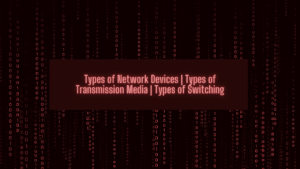Ever wondered “Why the study of Networking is necessary in the field of Cyber Security?”
The answer is that if we don’t understand that how the data is sent, received or transferred from one device to another, how devices communicate with each other, how can we secure our device and save them from attackers if we don’t know about Networking. We can’t do much in the field of Cyber Security without Networking. We have to know that how billions of devices on the internet are communicating. We study all of this in Networking because, Networking is the backbone of the field of Cyber Security.
Why do we need to study Networking?
To Understand How Everything Connects
Every time you open a website or send a message, there’s a Network making that happen. Studying Networking helps you see the logic behind it.
To Fix Internet Issues Like a Pro
Ever your Wi-Fi go down and you don’t know what to do? Knowing Networking means you won’t have to depend on someone else, you’ll know yourself what’s wrong.
To Keep Your Data Safe
Hackers often target Networks. If you understand how Networks work, you can better protect your devices, your data, and even your company.
Because Everything Runs on Networks Now
From smart homes to remote work to cloud storage, Networks are the core of all. Understanding them keeps you ahead of the curve.
For Career Growth in Tech
IT, Cyber Security, Cloud Computing, and Ethical Hacking all need decent Networking skills. It’s a must-have if you’re aiming for a tech career.
To Be Self-Sufficient in a Digital World
Knowing Networking gives you confidence. You stop guessing and start understanding what’s happening with your devices and connections.
What is Networking?
Networking simply means the process of connecting computers and other devices together so they can communicate, share resources, and exchange data.
What is a Network?
A Network is a group of two or more connected devices that can share resources, exchange data, and communicate with each other. These devices can be smart phones, computers, servers, etc.
All the user-end devices that are connected to the Network are called Nodes.
Types of Networks (based on Architecture or Design)
1. Peer-to-Peer (P2P) Network
In a peer-to-peer network, there are minimum two devices, all devices are equal. Each one can act as both a client and a server, meaning they can both request and provide services.
Features:
- No central server
- Easy to set up
- Common in small networks (like home or small office setups)
2. Client-Server Network
In a client-server network, there is one or more dedicated servers that manage and provide resources or services to multiple client devices.
Features:
- Centralized control and management
- More secure and scalable
- Common in large organizations
Types of Networks (based on Geographical Size or Scope)
1. PAN (Personal Area Network)
Range: 1-10m
A PAN is the smallest type of network, typically used for personal devices within a short range.
Example: Connecting your smartphone to wireless earbuds or a smartwatch via Bluetooth.
2. LAN (Local Area Network)
Range: Within a building or campus, maximum 1km
A LAN connects devices in a limited area, such as a home, school, or office.
Example: Computers and printers connected in a school lab.
Note: LANs are fast and often managed privately.
3. WLAN (Wireless LAN)
Range: maximum 100m
A type of LAN that uses Wi-Fi instead of cables.
Example: Your home Wi-Fi network.
4. MAN (Metropolitan Area Network)
Range: Within a city or large campus, 5-50km
MANs connect multiple LANs in a city or large area, often used by ISPs or large organizations.
Example: TV cable connection.
5. WAN (Wide Area Network)
Range: Country or even global
WANs connect devices over long distances and often use public networks like the Internet.
Example: The Internet itself is the largest WAN.
6. SAN (Storage Area Network)
Used to provide high-speed access to storage devices. Often used in data centers.
Example: Banks or cloud service providers using SANs for fast data access.
7. VPN (Virtual Private Network)
Not a physical network, but a secure virtual connection over a public network (usually the Internet).
Example: Remote employees using a VPN to access a company’s internal systems securely.
Types of LAN (Topologies)
1. Bus Topology

Structure: All devices share a single central cable (called the bus).
Pros:
- Easy and cheap to set up
- Requires less cable
Cons:
- Difficult to troubleshoot
- One fault can bring down the whole network
- Not scalable
2. Star Topology

Structure: All devices connect to a central hub or switch.
Pros:
- Easy to manage and troubleshoot
- Failure of one device doesn’t affect others
Cons:
- If the central hub fails, the whole network goes down
- Requires more cable
3. Ring Topology

Structure: Devices are connected in a circular loop. Data travels in one direction (or both in dual-ring).
Pros:
- Organized data flow
- Good performance under light load
Cons:
- One break can disrupt the entire network
- Difficult to reconfigure
4. Mesh Topology

Structure: Every device is connected to every other device.
Pros:
- Extremely reliable and fault-tolerant
- High security
Cons:
- Expensive and complex to set up
- Not practical for small networks
5. Tree Topology

Structure: A combination of star and bus topologies. Devices are grouped in star setups, connected via a bus backbone.
Pros:
- Scalable
- Easy to manage in layers
Cons:
- If the backbone fails, entire network sections can go down
6. Hybrid Topology

Structure: Any combination of two or more different topologies.
Pros:
- Flexible and scalable
- Can be designed to meet specific needs
Cons:
- Can be complex to configure and maintain
How Devices Connect to the Internet
To access the Internet, your device (like a phone or laptop) must connect through a network provider using one of several available technologies.
Here are some most common types:
1. DSL (Digital Subscriber Line)
- How it works:
DSL uses existing telephone lines (copper wires) to transmit data without interrupting voice calls. - Speed:
Moderate, typically up to 100 Mbps (varies by distance from ISP). - Equipment needed:
DSL Modem and Phone line splitter - Pros:
- Uses existing infrastructure
- Dedicated line (not shared with neighbors)
- Cons:
- Slower than cable/fiber
- Speed drops if you’re far from the exchange
- Common Use:
Homes in rural or older urban areas
2. Cable Internet
- How it works:
Uses the same coaxial cable lines as cable TV to provide internet access. - Speed:
Faster than DSL, can reach up to 1 Gbps or more. - Equipment needed:
Cable Modem and Coaxial Cable - Pros:
- Fast and widely available
- Reliable for streaming and gaming
- Cons:
- Shared bandwidth speeds may drop during peak hours
- Common Use:
Urban/suburban homes and small businesses
3. Broadband (General Term)
- Broadband is not a specific technology like DSL or cable; it’s a general term that refers to high-speed internet access that’s always on and faster than dial-up.
- It includes:
- DSL
- Cable
- Fiber-optic
- Satellite
- Mobile data (4G/5G)
- Meaning of “broadband”:
“Broad” refers to a wide bandwidth i.e., the ability to send and receive large amounts of data quickly.
If you feel any difficulty in reading the article you can mentioned video below.





